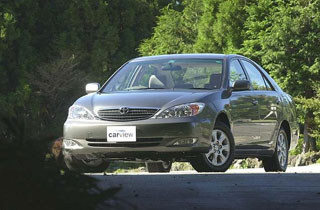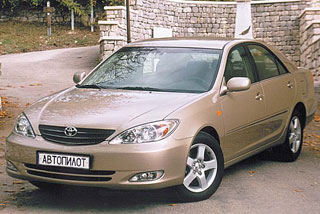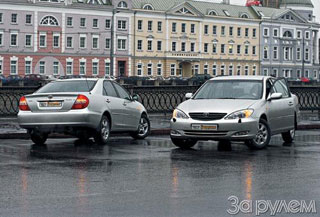Toyota Camry 2001 test drive - 2004 sedan
$12500-21500
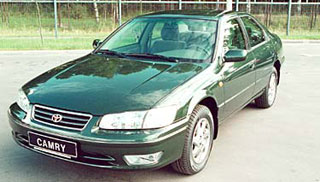 The advantages of this machine are difficult to evaluate at first sight. They appear only during the operation of Toyota Camry.
The advantages of this machine are difficult to evaluate at first sight. They appear only during the operation of Toyota Camry. The latest generation model (popularly - Camry in the twentieth body) debuted in 1997 and is released to this day. The car is enormous in America, but in Russia somehow did not gain proper popularity. This is primarily explained by a faceless, frankly Americanized appearance. The body with a minimum of outdoor decoration is perceived by the displaced from a wooden bar. Even the anterior and back lighting equipment is present on it, it seems, only because it is a prerequisite for the car. A unpretentious interior of light gray or coffee-brown (again to please the tastes of the Yankee) is complemented by the picture of the visual cheapness. The feeling is as if you are just sitting in a big kingolla.
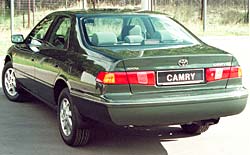 OPTICAL ILLUSION. Nevertheless, distillery specializing in three -year -olds consider the new Camry very profitable goods. The car, as a rule, leaves without long bidding and persuasion: he came, looked, checked the documents, technical condition and - money on a barrel. The fact is that this car is bought mainly by those who traveled on the previous Camry, produced in 1991-1996, or on other Toyota models. The main trump card of the machines of this brand is paradoxical: on the go, they are perceived much more solid and nicer than look outside. And Camry is no exception. The machine affects the magnificent smoothness of the stroke and sound insulation.
OPTICAL ILLUSION. Nevertheless, distillery specializing in three -year -olds consider the new Camry very profitable goods. The car, as a rule, leaves without long bidding and persuasion: he came, looked, checked the documents, technical condition and - money on a barrel. The fact is that this car is bought mainly by those who traveled on the previous Camry, produced in 1991-1996, or on other Toyota models. The main trump card of the machines of this brand is paradoxical: on the go, they are perceived much more solid and nicer than look outside. And Camry is no exception. The machine affects the magnificent smoothness of the stroke and sound insulation. And the suspension? Not shy-vague and not tough, it swallows potholes with the softness and elasticity of cat's paws. To understand how nice Camry is, imagine the front-wheel drive Mercedes E-Klasse. And knowledgeable people value Camry for phenomenal reliability and endurance.
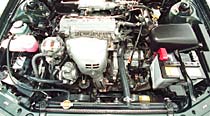
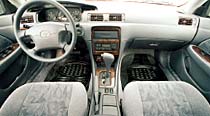
PEDIGREE. Before starting the search for the machine, it should be noted that Camry is sold in many markets - European, North American and Middle Eastern (right -handed regions do not count). Russia belongs to the European one, so that the system of after -sales support of cars (service, spare parts) is focused on Eurospection. However, to quickly deliver a non -European spare part or to undergo inspection with the lighting technology of the American standard today is not a problem. The main thing is that cars in the American and Arab versions were imported at one time not because they were something better than Europeans, but to save, including at customs. Therefore, among the Americans and Emirates, imported into Russia, there are practically no cars customized with the full payment of the established payments. It is possible that one day the state politely asks to pay extra.
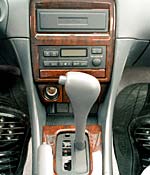 So, we are looking for Camry in the European specifications. You can immediately exclude models with the American (VIN with 4T) and Australian (6t) past from the candidates. Only cars made in Japan can be considered, as evidenced by the Vin-Nomer, starting with JT. In this case, the American version can be identified by a speedometer marked in a miles and the absence of a European standard icon (letter E with a digit in a circle) on the glass of lighting equipment. Well, a sign of the Middle Eastern Specification is the inscription of Arabic scribble on the rear-view mirrors and various premises under the hood. Nevertheless, the most sure way to find out the genealogy is to rewrite all the data from the sub -heater of the identification plate and show them to the employee of the spare parts department in any authorized Toyota technical center.
So, we are looking for Camry in the European specifications. You can immediately exclude models with the American (VIN with 4T) and Australian (6t) past from the candidates. Only cars made in Japan can be considered, as evidenced by the Vin-Nomer, starting with JT. In this case, the American version can be identified by a speedometer marked in a miles and the absence of a European standard icon (letter E with a digit in a circle) on the glass of lighting equipment. Well, a sign of the Middle Eastern Specification is the inscription of Arabic scribble on the rear-view mirrors and various premises under the hood. Nevertheless, the most sure way to find out the genealogy is to rewrite all the data from the sub -heater of the identification plate and show them to the employee of the spare parts department in any authorized Toyota technical center. I’ll consider the options ... the latest generation can be bought only with the sedan body - the station wagon has gone the past with the previous model. Therefore, only the engine will have to choose, by and large, a four -cylinder with a volume of 2.2 liters or a three -liter V6. Even the checkpoint - manual or automatic - can only be obtained under the condition of the four -cylinder engine, and the powerful V6 unambiguously condemns to the machine. The minimum and maximum configurations are so close that they are fundamentally only different in upholstery: velor or leather. On three -liter machines there are both options, and more modest two and two usually implies velor. In the leather cabin, the front seats are equipped with an electric drive and, as a rule, heated, and for velor configuration this options. By the way, check the work of heating the seats, especially the driver’s. If the file part of the body does not feel anything, it means that you will have to replace the heating element in the pillow, which costs $ 211. Perhaps this is the only characteristic sore in electrical equipment. Another car can be with a hatch in the roof or without it; With two or four airbags. The remaining means of ensuring comfort-an electric package and automatic climate control-you will receive guaranteed.
On the market there are both instances brought from abroad and those that all their kilometers wound around Russia. To date, the average mileage of cars is 80-120 thousand km, and most of them are in good condition. Nevertheless, do not forget that three years or 100,000 km of run is the first transitional age for Camry, when you need to replace all technical fluids and many consumable parts. Therefore, many owners, knowing that the car soon sells, ignore the execution of the requirements. Especially sin of jerking Europeans. Accordingly, a complete revision of the car at the branded technical center before buying is required.
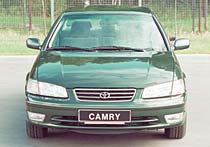 A boring story about two brothers. The four-cylinder engine of the 5s-Fe model has proven itself on the previous Camry. In addition to the regulatory replacement of oil and filters, it will require a rather frequent replacement of candles, for which a run of 20,000 km on our gasoline is a record. By the way, oil in candle wells (very rarely found) is not a reason for panic. The leak is eliminated by elementary planting of wells on sealant.
A boring story about two brothers. The four-cylinder engine of the 5s-Fe model has proven itself on the previous Camry. In addition to the regulatory replacement of oil and filters, it will require a rather frequent replacement of candles, for which a run of 20,000 km on our gasoline is a record. By the way, oil in candle wells (very rarely found) is not a reason for panic. The leak is eliminated by elementary planting of wells on sealant. The rest of the motor maintenance work is minimal. For example, the timing belt changes only after 100 thousand km ($ 160 with work), and for the first time without the usual replacement of rollers. When re -updating the belt, in addition to a pair of rollers ($ 125), a water pump ($ 205), as well as the front oil seal and the camshaft oil seal ($ 12), will surely require replacement.
The three-liter V6 model 1MZ-FE in terms of characteristics and appearance is almost a copy of the three-liter motor of the previous Camry, prone to overheating and giving out the gaskets of the block heads. But not in vain, the engine was assigned a new index - its design was changed, and it is completely deprived of this deficiency.
Everything that is said about servicing a four-cylinder engine is also fair for the six-cylinder, except that the candles with platinum spraying of the electrode used on the V6 serve 40-50 thousand km. Such a rare need for replacement fully justifies the higher cost of platinum candles - $ 12 apiece, not $ 3. The story about the engines turned out to be extremely stingy. But what about the small dirty tricks of the power and engine control system, which have become the norm in our conditions? Well, gas pumps, nozzles, various sensors and high -voltage wires do not fly on Camry engines. They even never knock on valves in them - because they simply do not. Both gearboxes are absolutely trouble -free, provided that the oil is replaced in them after 40,000 km. On cars equipped with mechanics, the clutch with proper operation serves about 150,000 km. True, the original set of adhesion (it is better to change in the collection), like all Japanese spare parts, nonsense - $ 335.
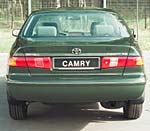 HOW IS YOUR HEALTH? Do not wait. The only weak place in the suspension is cups of the upper supports of the front shock absorbers on cars until 1999. They are out of order already for 20-30 thousand km and begin to knock disgustingly when potholes travel. New cups with bearings and lining under the springs cost $ 312, and three normal hours are allocated to replace them.
HOW IS YOUR HEALTH? Do not wait. The only weak place in the suspension is cups of the upper supports of the front shock absorbers on cars until 1999. They are out of order already for 20-30 thousand km and begin to knock disgustingly when potholes travel. New cups with bearings and lining under the springs cost $ 312, and three normal hours are allocated to replace them. If the question with cups is closed, then every 30,000 km you have to change the rubber bushings of the stabilizer (penny costs) and to revive brake calipers acidified from salt and dirt about once every two years - usually the front ones. Road salt also tightly grabs EXCentric bolts that regulate the angles of installation of the rear wheels. Therefore, if you have to go to the convert, a couple of bolts is better to buy in advance. The life of the brake discs is highly dependent on the driving style, but the front lasts 60-100 thousand km, and the rear ones are one and a half times longer. On average, for 100 thousand km there are enough shock absorbers and stabilizers.
The rest of the details-steering rods and their tips, ball supports and front levers with silent blocks, all six rods of the rear suspension-remain relatives on cars even with a mileage of 150-170 thousand km, if there were no emergency situations. According to the experience of the previous Camry (there are no latest generations with such a mileage yet), serious diseases appear to about two thousand thousand ... Note, on our roads! Therefore, if you take a car with a real mileage of 80--100 thousand km in Europe to date, then you have another 120--140 thousand in stock before you entrust large expenses to the next buyer.
Text Alexander Konov, photo Sergey Sherestnikov
We thank the Toyota-Center Silver Bor, (095) 199-5977.
Toyota Camry 2.2 3.0 V6
Working volume (cubic cub) 2164 2995
Power (L.S.) 131 190
Maximum speed (km/h) 200 220
Acceleration to 100 km/h (sec.) 10.4 9
Fuel consumption of highway/city (l per 100 km) 6.9/8.7 12.2/16.2
Prices for AM Toyota Camry in Moscow (for October 2001) 2.2 3.0 V6
Year of release price
1997 $12 500--14 500 $17 000--19 000
1998 $ 14,000-16,000 $ 18,000-21,000
Prices for original spare parts and consumables for official dealers
Oil filter $ 5.5
Air filter $ 28
Fuel filter $ 35
Brake pads, per./Ass. $ 80/68
Brake disk, per./Ass. (pcs.) $ 165/156
Ball support (pcs.) $ 78
Front suspension lever (pcs.) $ 295
The reactive thrust of the rear suspension (pcs.) $ 89-118
Farah assembly $ 260
Rear lamp assembly $ 105
Bumper assembly, per./Ass. $ 431/449
Lobe glass $ 650
Door glass $ 140-170
Front wing $ 350
The stingy will not pay at all. Prices for original Toyota dealers are sometimes perceived with difficulty. Can I save? In this case, you do not have to count on independent manufacturers. It is on German cars from a high -quality non -original you can assemble all the chassis and half a motor. And for Japanese machines, a wide range of non -original parts appears only five years after removing the model from production. On third -party blocks, belts and filters, you can’t particularly save. And the cheap Taiwanese body iron is not a fact that it is suitable, and even more so there is no guarantee that in two years it will not rust through through. Perhaps the only one is one hundred percent justified by non -original is the Finnish windshield, which costs $ 120. Thus, it remains to look for only cheaper original spare parts. In Moscow, St. Petersburg and other large cities now there are enough small companies specializing in the Toyota original. To make an idea of \u200b\u200btheir price level, you can safely discard from the 25-40 percent given in the text and table. It all depends on the name of the part, its presence in the warehouse and urgency of the order, if there is no one (an urgent order of large -sized spare parts sometimes equates the price with dealer).
Finally, disassembly. It makes sense to buy details that died not their death. For example, I found a pretty decent headlight for $ 60 and a fresh automatic box with a bat for $ 1200. Its performance was guaranteed subject to installation on the local service. True, according to employees, disassembly, details on fresh models are a rarity.
A source: "Autopilot"
Toyota Camry 2001 - 2004 Video Video
Toyota Camry 2001 - 2004 Krash
Toyota Camry 2001 test drives - 2004
Toyota Camry 2001 - 2004
Toyota Camry: Detailed Information| Camry 2001 - 2004 | |
|---|---|
| Engine |  |
| Transmission |  |
| Control system and suspension |  |
| Brake system |  |
| Air heating and air conditioning |  |
| Launch and charging system |  |
| Electric components and so on |  |
| Corrosion body stability |  |










